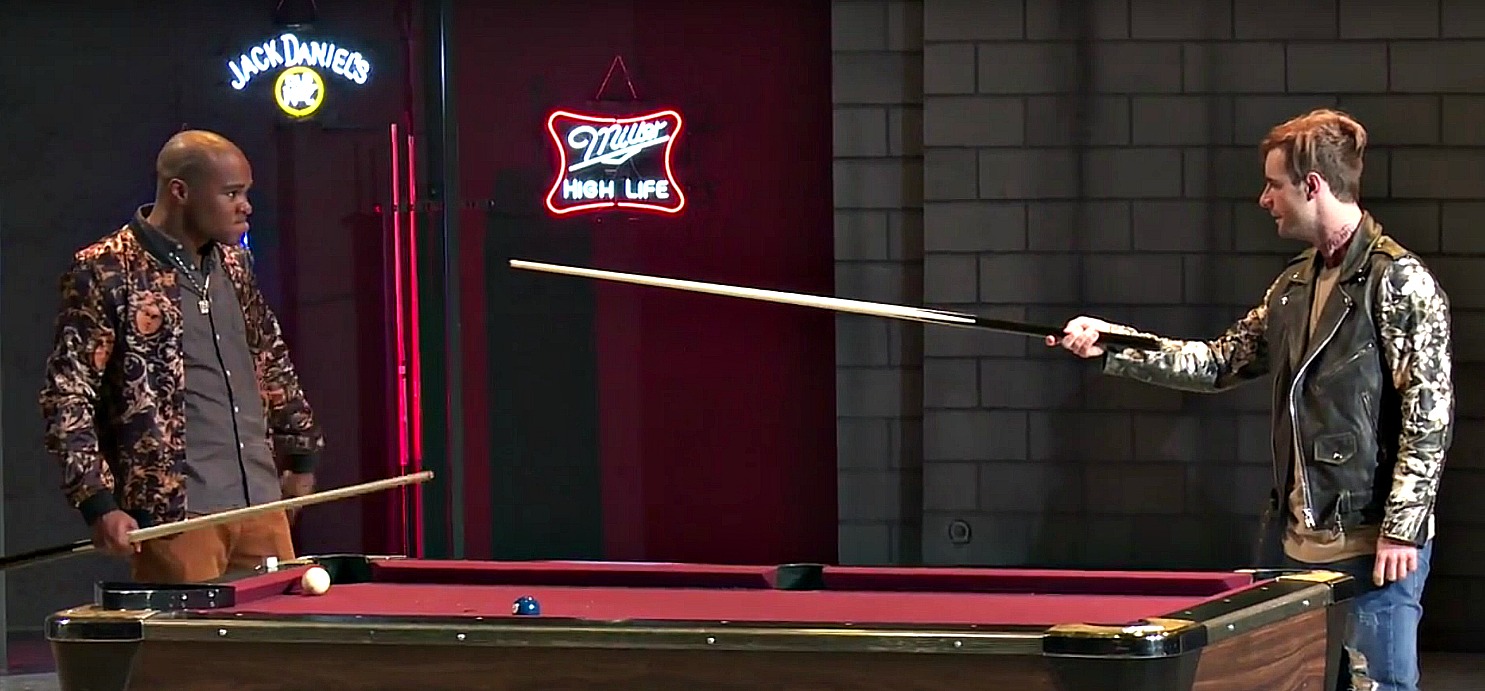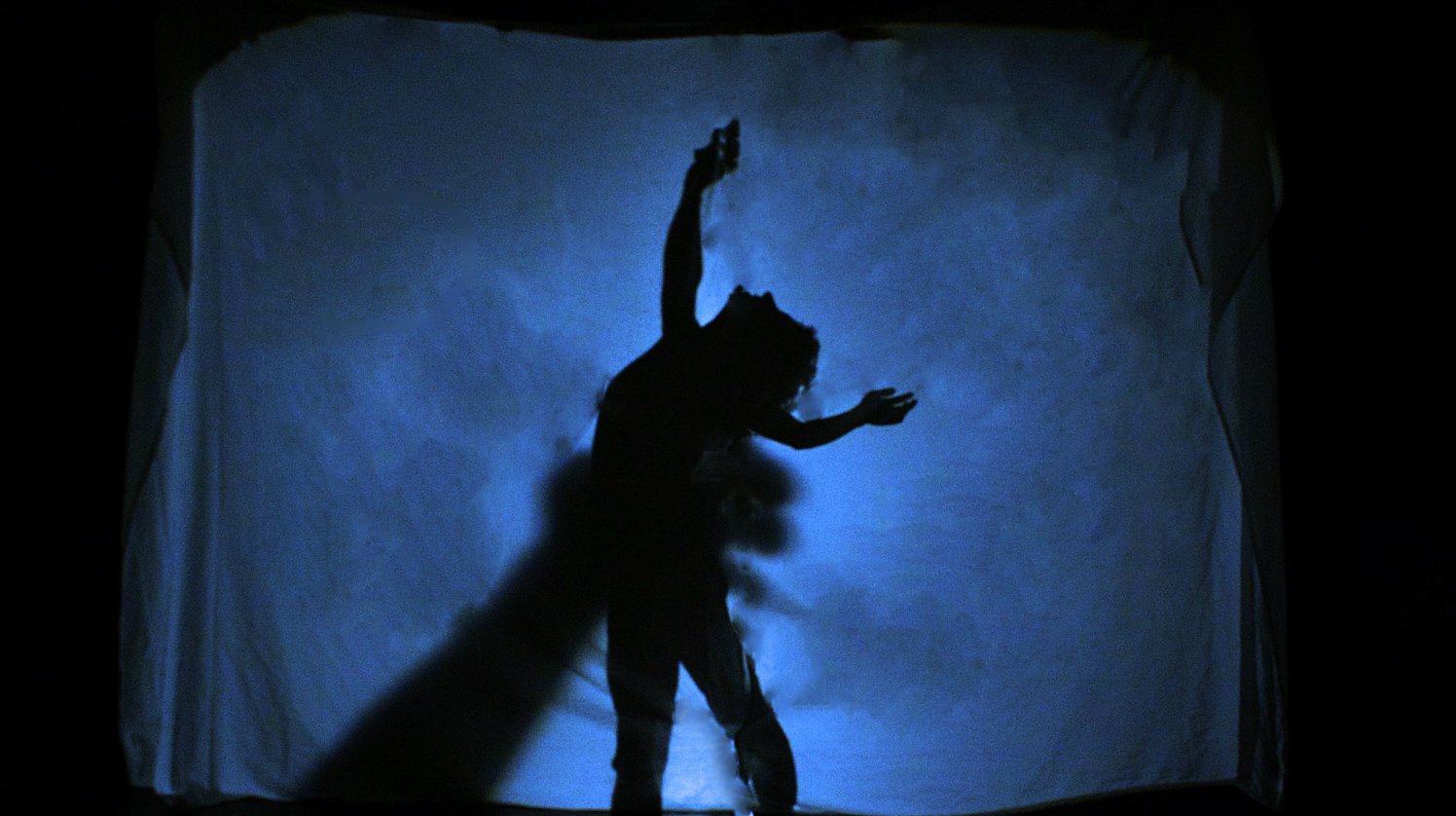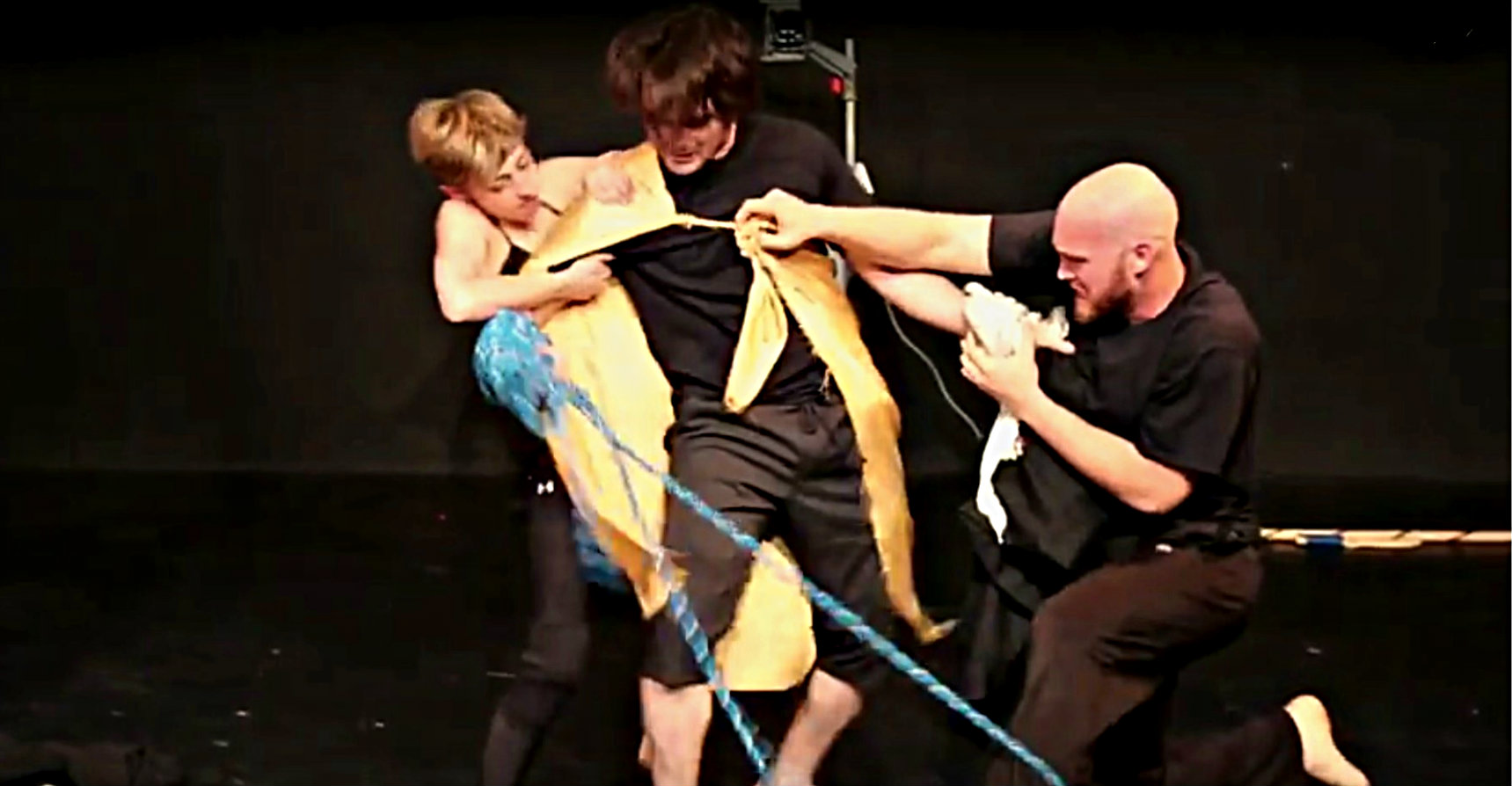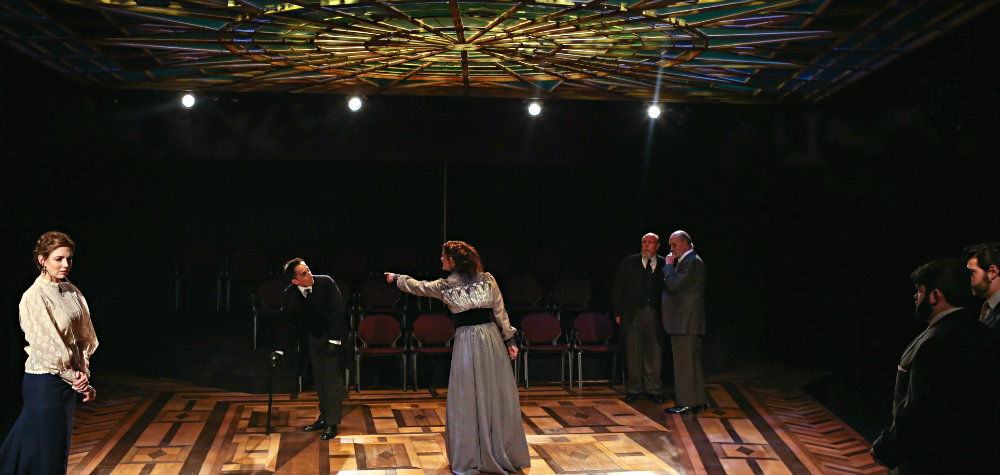Try Not To Kill The Actors
ArtandSeek.net July 6, 2017 48Welcome to the Art&Seek Artist Spotlight. Every Thursday, here and on KERA FM, we’ll explore the personal journey of a different North Texas creative. As it grows, this site, artandseek.org/spotlight, will eventually paint a collective portrait of our artistic community. Check out all the artists we’ve profiled.
The 1938 movie, ‘The Adventures of Robin Hood’ was so successful, it’s one of the rare swashbucklers ever to be nominated for a best film Oscar. And Errol Flynn’s climactic swordfight with Basil Rathbone (as Sir Guy of Gisborne) became a benchmark in cinematic swordplay.
The two-minute, twenty-second sequence may seem brief and tame by today’s standards. But that’s because for nearly 80 years, film directors and fight choreographers have been trying to top it – from ‘The Duellists’ to ‘The Matrix’ and ‘The Three Musketeers’ (the one with Oliver Reed and Michael York), from “The Princess Bride” to ‘Kill Bill’ and “Crouching Tiger, Hidden Dragon.’ If nothing else, the Flynn vs. Rathbone fight – staged by British fencing master Fred Cavens – made swinging a sword as central to Robin Hood’s legend as shooting arrows.
So ‘Hood’ – the new Robin Hood musical at the Dallas Theater Center – delivers four swordfights, plus other punch-ups and disagreements. This morning, Jeffrey Colangelo is rehearsing the first confrontation between Robin Hood, played by Nick Bailey, and the villainous Sheriff of Nottingham, played by Austin Scott. This isn’t fencing with rapiers; the actors are hauling around two-handed broadswords (as Flynn and Rathbone did). Robin is trying to rescue one of his ‘merry men’ from the Sheriff, and it’s a classic up-and-down-the-staircase fight but it’s also marked by the two characters’ distinctive fighting styles. This is the first time the Sheriff has ever come up against anyone like Robin. He’s someone who casually defies the Sheriff but also can defend himself with a sword.

One of the most famous confrontations in Shakespeare: Tybalt (Robert George) vs. Mercutio (Drew Foster) in the Dallas Theater Center’s ‘Romeo and Juliet.’ Fight choreography by Jeff Colangelo.
“That first fight,” says Colangelo, “is really important in establishing the tone of the fighters and how their personalities work through movement. The Sheriff of Nottingham is a person who solves his problems by bull-rushing through. And Robin Hood – he’s so skilled that he’s able to play with the Sheriff and adapt to dangerous situations.”
Robin’s swordfighting is clearly more fluid, more improvisational — all of which indicates, if a fight scene is any good, it’s more than just an interlude for some violence and calisthenics. A good fight reveals character. It’s a mini-drama. Here, it also helps set the feel of ‘Hood.’ We’re not getting bone-crushing, eye-gouging violence – this is the England of boyhood legend and high spirits.
Colangelo even sees a duel as a conversation, a debate between two characters, a debate “about the very nature of their existence. One person does not want the other person to exist. And they debate that existence through my fist and your face.”
The past three years, Colangelo has become, in effect, the house fight director at the Theater Center. He’s worked on a dozen shows there. His artistry has been a highlight of such physical productions as ‘Romeo and Juliet’ and ‘Oedipus el Rey.’ He’s also worked with Kitchen Dog Theater, Cara Mia and the Trinity Shakespeare Festival.
In fact – as is true for most fight directors – William Shakespeare is Colangelo’s paycheck. What other playwright uses swords as an everyday fashion accessory? Take away the swords, and there’s still no competition. No other playwright provides fight directors with so many duels, battle scenes and brawls, even in his comedies.
And Shakespeare does this annually.

Prismco’s ‘Persephone’ – the title character, played by co-founder Katy Tye, is dragged down to Hades.
“Man, I love Shakespeare season,” Colangelo says with a laugh. “That’s when I know I’m making a living. Partly it’s because directors know they need to hire a fight choreographer with Shakespeare. They can’t just wing a swordfight. Shakespeare was really like. I really think he was the Quentin Tarantino of his day. He loved violence. Violence was one of the best ways to get people involved in his plays.”
But even your typical modern-day drama can contain hair-pullings, slappings, kickings. Colangelo says these can also use a fight director to make them convincing – and safe. But many theater companies don’t see the extra time and expense as worth it.
David Lozano, artistic director of Cara Mia, says that before Colangelo became a company member, “the directors were choreographing their own fights, which, looking back, was not a good idea aesthetically nor in terms of safety. But it’s just been really a harmonious relationship. Instead of just pre-choreographing, Jeff really appreciates the opportunity to explore movement with actors.”
If he’s got a decent rehearsal schedule, Colangelo says, he likes to tailor the fights. Realize that, in many instances, the only stage direction in the script he has for guidance is simply “They fight.” And maybe “that guy wins.” The fight director has to fill in the rest — “complete the text,” as Colangelo says. So he likes to take the time to learn the actors’ different abilities and to help train them, not in fight techniques but in how to act a fight.
That’s because faking violence, making bloodshed believable – these are some of the oldest stage illusions. Essentially, fight direction is theater stagecraft plus martial arts. With the 26-year-old Colangelo, that’s literally true. He grew up in Orlando, Florida, the son of theater parents. He began learning tae kwon do at the age of 7 – and not because he was an eager athlete.
He was, he says, a scaredy cat who loved the movie, ‘The Karate Kid.’ And wanted to be a Power Ranger.
“My interest came from the very shallow cool factor. I wanted to be awesome,” he admits. “And I wanted to feel powerful. I wanted to feel like I could take on things. I used to have a lot of nightmares as a kid, visceral nightmares I still remember today. And after I started taking martial arts, I started imagining myself beating those nightmares back. Honestly, I don’t really have nightmares anymore.”

Tangled up in blue (and yellow): Katy Tye, Jeff Colangelo and Brandon Whitlock in Prismco’s ‘Medea.’
Colangelo attended SMU, studying under North Texas’ masters of fight choreography, Bill Lengfelder and Sara Romersberger. By the time he graduated in 2013, he was proficient with weaponry and stage combat but also clowning, juggling, fire-spinning – almost any kind of movement onstage. This helps explain his co-founding the unique local company, PrismCo, the same year he graduated. PrismCo is dedicated entirely to movement theater, theater without words.
“I wanted to be able to continue making longer stories to these fight scenes,” Colangelo says. “Luckily, I found a very good co-founder, Katy Tye, who was like, ‘And we’re also going to do other things!’” he says, laughing. “And she introduced this dancing, acrobatic element.”
PrismCo productions like ‘Penelope’ and ‘Bruises’ (below) have told stories entirely through shadowplay, mime, gymnastics and stage combat. Perhaps Prismco’s most ambitious effort is set for this October: a five-actor ‘King Lear.’ A wordless King Lear.
We’re back at the rehearsal for ‘Hood.’ “Let’s do it one more time slowly,” Colangelo says, “and then we’ll move it up to walking speed.”
Bailey and Scott’s sword-clanging starts up again, beating out the rhythm of this fight like battling metronomes. For the Theater Center’s new musical, ‘Hood,’ almost the entire design team was imported from New York, right down to the wig designer. It’s a sign of Colangelo’s achievement he’s one of the few Dallas artists on the team. He’s earned it.
Because that’s what the art of stage combat is all about.
Actions speak louder than words.
When did you first call yourself a fight director?
As a theater artist, I realized I was probably stuck in theater sophomore year of high school. But as a fight choreographer, I knew it was my goal, but I didn’t realize how professionally I could do it, how I could make money doing it until I was in senior year of high school.
It’s very fortunate it was so early, but I have the extreme good fortune of having parents who have always looked at art as a business. They understand the necessity of having to view yourself as a freelance contractor on top of satisfying what you need artistically.
‘Bruises’ featuring Jasmine Segar, Carissa Jade Olsen and Haulston Mann. Video: Jerome Weeks
Did you ever have a day job in order to pursue your career?
I’m incredibly lucky to have had only two day jobs since graduating from college. The first one was at Starbucks – which was the usual kind of awful Starbucks experience. No need to go into great detail. But I remember at the beginning of my career, there were certain days where I had to wake up at 4:30 in the morning to do Starbucks, I’d finish Starbucks and almost immediately after Starbucks was done, I’d go either to do production for a Prismco show or start rehearsals or teach. It would be full-on, 4:30 mornings to midnight da ys. [Laughs.] It was rough.
My second job, I actually worked at a martial arts studio called Pro Martial Arts at Lakewood. It’s a wonderful little studio. I ended up stopping working there because I simply didn’t have the time anymore. But they’ve actually been wonderful help even after I stopped working for them. For ‘Bruises’ [the traveling Prismco show about female mixed-martial arts fighters], a lot of the people who go to that studio ended up in the show, and they sometimes would offer us their studio to train for a day or two. They’re really wonderful people.
Are there any rituals you follow – before rehearsal, before you start creating a combat sequence?
As a fight director, I find that if I can find a piece of music that might fit the feeling of the fight or its rhythm that can help inspire me to create the right feel and tempo. And then another thing I do is start from big, mental pictures – what are some big still photos that really exemplify what’s going on between these two characters? And if I can get these interesting stills to happen then I simply shape the rest of the fight around that. I use that as the climactic points in the fight.
What have you given up to pursue this – if anything? It doesn’t have to be something you regret, I’ve lost all of my family life. One artist said he didn’t have to put on a suit and tie and go to an office 9-5 everyday, so that was something he happily gave up.
I don’t have a 9 to 5 schedule anymore, and I think I may have sacrificed my ability to get back into a 9 to 5 schedule again – sanely. But in a lot of ways, I work really hard, and my work is my life. So I don’t have an amazing social life – if that if that means anything. But I don’t think I ever really wanted that. That’s why I’ve chosen to be an artist, obviously [laughs].
Are you creatively satisfied?
I think I’m creatively satisfied in the diversity of things I can do. If I just stuck with being a fight director, I think I would become miserable. I would start to pick at myself that would make the job not-fun anymore. There are days when my small personal failures, they do add up to meaning a lot to me. When I end up seeing those on stage, they kind of hurt. I don’t know why, they mean a lot. I can’t stand it.
I don’t know why. It makes me feel like all the work I’ve done up to this point, why isn’t it working this time?

‘Richard III’ at Trinity Shakespeare Festival with Blake Hackler (second from left) as Richard. Photo: Amy Peterson
But do you learn anything from them? Is the self-criticism useful, you can move forward with it or does it leave you stuck, feeling sorry for yourself?
Yes, I do try to learn from it but – and I know this sounds irrational and I think that’s where these soul-crushing things come from sometimes – but if enough of those were to hit me back-to-back, I would want to sit out of it for awhile.
So PrismCo would be a relief from that? Some of it is fight choreography, obviously, but much of it isn’t. It’s telling a story entirely through movement and not necessarily through physical combat.
It’s such a relief from that. Because I’m able to exercise in a completely different way. If there’s fight choreography in PrismCo, it’s generally secondary. I’m not hired to pour my entire being into just these two minutes. Instead, I can focus on a larger picture and put a larger puzzle together. I’m not the world’s greatest playwright with dialogue, but I love trying to express something without words. And yes, if something goes wrong, there are stakes involved and it makes me crazy if we don’t have an amazing play, but now, it’s just my fault. I’m not a hired gun, as it were. I can actually manage these things I often can’t control and be in charge of my own destiny and the play’s destiny.
So I think having a diversity of things to do – teaching, too, is actually really nice as a break. If I did nothing but teaching, I’d probably get sick of it, too. But being able to jump around all these different jobs – I’ve actually even picked up stage managing recently, something I thought I’d never do in a million years. But I’ve actually started stage managing for Lone Star Circus and it’s an awesome job. I love it. I love working for the circus.
Turning chaos into order is fun – for me, it’s fun, anyway. And I don’t have much time to do it, so I don’t have much time to get bored by it. I have to solve this giant puzzle very, very quickly.
Interview questions and answers have been edited for clarity and brevity. Top image from shutterstock.









